#ACME Productions
Explore tagged Tumblr posts
Text
Malibu Country | TV Show
Title: Malinu CountryCountry: United States of AmericaYear: 2012Genre: ComedyNetwork: ABC StudiosProduction: NestEgg Productions (pilot)Blah, Blah, Blah Productions (episodes 2-18)Acme ProductionsABC StudiosSeason(s): 1Episodes: 18 ⭐⭐ Rating: 2 out of 5. Reba McKenzie suddenly single when she finds out that her singer husband was cheating on her. After putting her career on hold to be a wife…
#2012#ABC Studios#ACME Productions#Blah Blah Blah Productions#Cancelled Show#Comedy#Malibu Country#NestEgg productions#Newly Single#Reba McEntire#Singer#Single Parent#Television Show#USA
0 notes
Text
I’d love to forcefem someone using only loony-toons traps
Roll out of bed? Step on a button triggering a pulley that rips your pyjamas and underwear clean clean off
Stumble back from the shock? Trigger a slingshot that slaps you with a bra and a pair of panties that slip on due to the force (it’s a cartoon!)
Try to take them off? It snaps back so hard you eg pushed into your wall, triggering another button dropping a cute T-shirt perfectly over your head
Stumble around trying to see? Fall over a tripwire through a skirt that gets together around your waist as you slip through it
And then you find yourself in a fem get up scared to do anything, you sure won’t try to take it off anymore
So you’ll maybe open a cabinet to get your toothbrush? Cannon shoots you with a perfect face of make-up
But at least you could grab your (mysteriously) pink toothbrush now
You walk out of your room? Step inside high heels that clamp onto your feet and then stumble down the stairs falling into a kiddy-pool filled with Estrogen gell
Not to mention all the traps I can set at their workplace and on their way to work, all the traps I can make that you’d only ever trigger if you’re actively avoiding other traps…
And just how insane she’ll look to everyone else, of course the traps never activate when someone else could see it, so to everyone else she just looks like a crazy, but cutely dressed, girl
I might even make a trap attaching a fun little bomb to her, which will go off if she ever denies that she’s really a girl (and if the bomb ever happens to go off it will conveniently launch her inside a seat of the closest beauty salon, with her to confused by the blast to resist the full manicure we’ve order for her)
#Were is ACME’s email! We need to set up a new like of products and instal them in everyone’s homes right away!!!#.#forcefem#i-like-talking#..#bug’s bunny would agree#we need more violent forcefem!#…#not proof read#so apologies for weird phrasing!
182 notes
·
View notes
Text

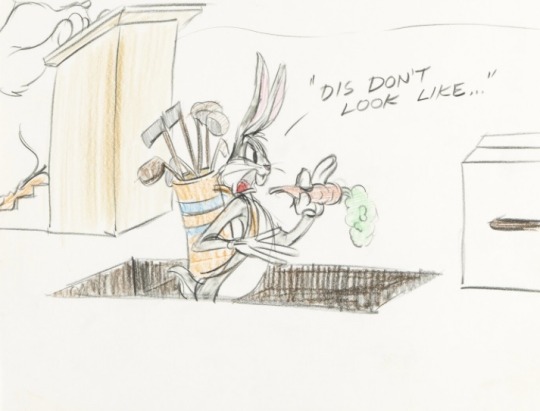
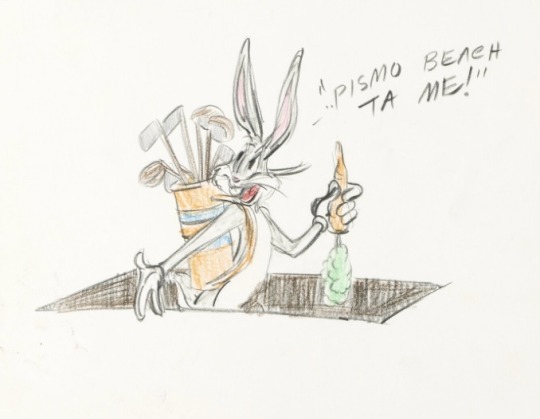

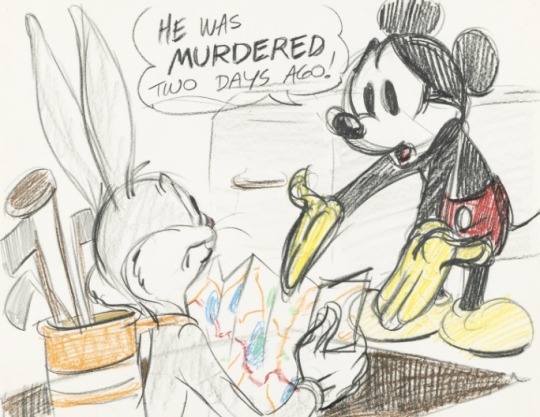
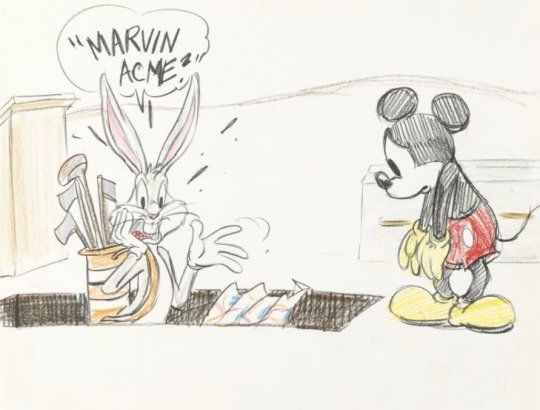
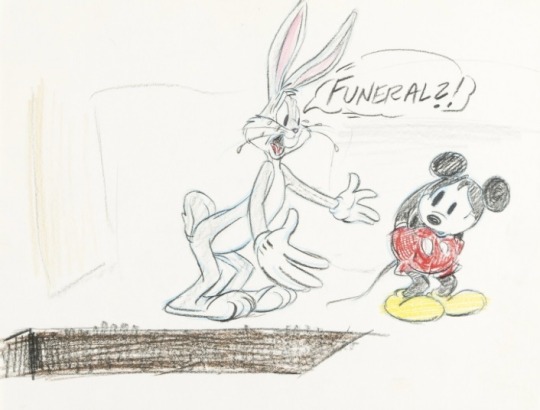
Deleted Scene Alternate Meeting “Who Framed Roger Rabbit” (1988)
#80s#touchstone pictures#amblin#disney#warner bros#hybrid film#who framed roger rabbit#crossover#deleted scene#marvin acme funeral#concept art#production art#storyboard#story sketches#bugs bunny#foghorn leghorn#mickey mouse#marvin acme
334 notes
·
View notes
Text
youtube
don't feel like uploading it separately here so here's just the yt link lol
made a proper talkloid again after a million years for rin/len/iku's bday (even if a bit late but fuck it)
#my video lol#talkloid#vocaloid#utau#kagamine rin and len#kagamine rin#kagamine len#acme iku#oliver vocaloid#ugh dont feel like tagging anything else. does this need any warnings???#and now for soemthing more lighthearted lol. tonal dissonance strikes back my fave. the iku gore post before this and now silly 💀 lol#anyways i love talkloiding fr... its like playing with dolls but even better lolll i missed doing this. i need to do more of this#its annoying as fuck and so time consuming but its always fun to watch the final product#i will say tuning len to make him sound like he's having a mental breakdown lowkey was really fun LMAOOOO#i figured out how to do that by accident and i wanna keep testing shit like that out. making vsynths sound sarcastic is also rly fun#maybe i really just need to keep on with that. cause as much as i do want to make nice covers or whatever maybe its not for me#though figuring out shit for song tuning has in turn helped me figure out things for speech & viceversa. so hmmm#i need to keep practicing so i can get better... bc technically this is all with purpose theres a deeper reason why im talkloiding#and every one i make is a step closer to the final mission. but we'll see if we get there soon some day... it will take time but one day...#also i need to get better at using aviutl lol figurign out some of thsi shit last min was NOT IT but we're getting there...
17 notes
·
View notes
Text
Behind the scenes editing!
Here's a little behind the scenes look of Breaking The Thin Blue Line, with countless hours of not just capturing everything on video and audio, but editing it all as well.
This has been an extremely fun project to do, and I'm excited to share it with you all very soon!
youtube
#uhwo acm#law enforcement#youtube#cinema#police#film production#capstone#short film#academic film#film#Youtube
4 notes
·
View notes
Text

The Warner Bros. Decision cancels Coyote vs. Acme Movie
February 9th 2024 Entertainment / Streaming / Film
KOSAMA
| Writer and Recovering Anime
The movie was originally going to be cancelled on November 9th, 2023. In response to the uproar, Warner Bros. decided to backtrack on its initial decision. Rather than axing the movie altogether, the studio opted to give the filmmakers an opportunity to pitch it to other studios. If another studio expressed interest in picking it up, they were welcome to do so.
But now several months, and Warner Bros. had reached a breaking point.
Now according to TheWrap, industry giants like Amazon, Netflix, and Paramount eagerly viewed for the opportunity to snatch up the rights to premiere Coyote vs. Acme, following Warner Bros.' reversal of stance. The studio graciously allowed the creators of the live-action/CGI hybrid project to explore other avenues, sparking a bidding war among the titans of entertainment.
Despite each studio reportedly presenting enticing offers, including Paramount's ambitious plans for a theatrical release, none managed to meet Warner Bros.' lofty expectations of the $75–$80 million range.
No one's 100% sure what lead to the decision though the likely explanation seems straightforward: there was a potential tax write-off of $75 million or more if the project were scrapped. Therefore, for Warner Bros. to forgo this tax advantage and allow a competitor to reap the benefits, the sale price would need to match or exceed that figure. Decision-makers likely crunched the numbers without even needing to watch the movie.
While it's evident that accounting laws should be revisited to discourage the abandonment of completed projects, it's understandable that executives would utilize the tools available within the current legal framework to maximize profits for their shareholders.
#warner bros#coyote vs acme#movie industry#film production#hollywood#movies#theater#netflix#paramount+#amazon prime video#prime video#amazon#looney tunes
4 notes
·
View notes
Photo


Tiny Toons Original Production Cel with Matching Drawing: Babs Bunny
MEDIUM: Original Production Cel with Matching Drawing IMAGE SIZE: 12 Field PRODUCTION: Tiny Toon Adventures, Acme Bowl SKU: IFA8858
#Acme Bowl#Tiny Toon Adventures#Tiny Toons#Babs Bunny#Football#Original Production Cel#Original Production Art#Production Cel#Production Art
2 notes
·
View notes
Text
The fact that there are entire completed movies that I will never have the opportunity to watch or even know about makes me so unreasonably angry
When I hear about these unreleased pieces of media I also think about the ones that we haven’t heard of. Just how many people’s efforts will never be acknowledged due to the greed of companies.
Is this scooby movie some high brow entertainment? Probably not but that absolutely shouldn’t matter, it could’ve some child’s hyper fixation leaving an imprint for their entire life. I have so many direct to dvd shows and movies that I remember with such fondness not because they were good but because I thought they were and I loved them anyway. The idea that I could have been deprived of any one of them due to some execs greed is horrible. For every show and movie not released, there’s someone out there who’s never seen their favorite piece of media
The fact that this is even remotely advantageous for a company to do I think is as good a sign as any that our current economic system is not functioning
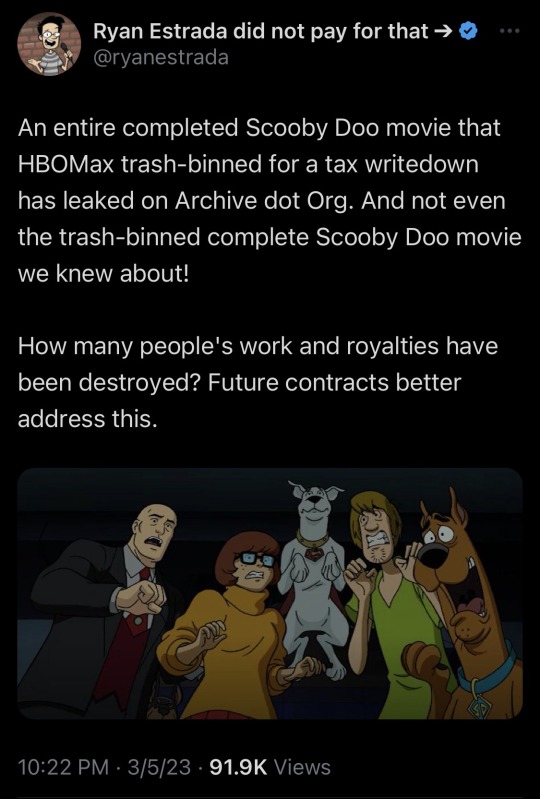
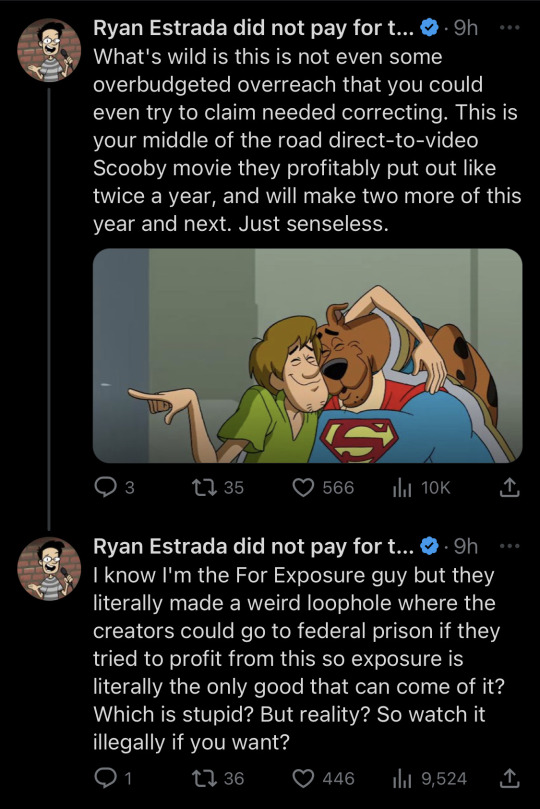
So apparently another whole ass animated scooby doo movie was canceled, this time featuring Krypto the Superdog, but it leaked onto 4chan and was uploaded onto the internet archive
#sorry this is so rambling#just putting thoughts into words and those thoughts aren’t that organized#the coyote vs acme movie is a tragedy#and apparently there were some leaks of production art of a completed and unreleased scooby doo show??
67K notes
·
View notes
Text
You know all those ugly yellow ladders found across northern Thedas?? Yes the ones that look new-ish and is by no means part of ancient elven architecture??
I'm convinced it's the Venatori who placed them, and that this implies that the Venatori has a silly Venatori factory that produces obscene amounts of ladders.
#its like like those ACME products in loony tunes cartoons#venatori hc#dragonage#veilguard no spoilers#datv#veilguard
0 notes
Note
Have you read her new book where her friend interviews her about all the Shakespeare roles she's played? She's hilarious.
I haven't! I really should, she's so delightful and I love how Shakespearean she is as an actress.
#i actually just unexpectedly saw king lear at acm last night which was just an insanely good production#(unexpectedly because a friend's husband got sick and she was like WELL i still want to go to this play and have two tix so took me instead#i'd wanted to go but couldn't justify the cost rn just between going to the us tomorrow + my sister's court stuff#robert menzies the actor you are#welcome to my ama
1 note
·
View note
Text
Acme Gear

🛴🎾🚀🎯🧨🎣
They got the gear. Trevor got himself a pair of jet skates, and Susanne got a scooter that she'll have to give to Polly.
0 notes
Text
As everyones fave tboy i do think its interesting that i saw tgirl boobs in a bra w the community label and then 5 consecutive posts of blatant untagged porn lmao wonder what thats about matty boy
#eli.txt#ik tmasc is probably next on your list#ban me like a real man pussy boy gonna go buy some acme products real quick
0 notes
Text
Good Omens graphic novel update: June 2024
Welcome to the June update. A lot of behind the scenes work at the moment but we're grabbing the travel sweets, popping in the Bentley and hitting the road. More on that below.
Admin
Ongoing reminder that the project FAQ can be found here.
I pledged using my Apple ID, or no longer use the address my pledge is attached to, or I cannot work out what email address my pledge is connected to. What should I do? Please contact us via your Kickstarter account where the pledge is connected; we will be able to see on our system which address it is. If it's one you have access to, great! The FAQ has information on how to resend your invite link to access the PledgeManager. If it's one you are not able to access, then you can let us know which email is preferred and we can update this on the system, which will automatically send a new invite.
Events
We've had a lot of queries about when the Good Omens team will be attending events more formally, after some Aziraphale and Crowley spotting at conventions we'd been to previously. Well, we're excited to confirm the first: Good Omens HQ will be at ACME Comic Con in Glasgow, Scotland this September.

We'll be bringing the actual-real-life-home-to-Crowley-and-his-plants Bentley from Season 2 of Good Omens, the first time the car has been made available publicly for fans to come see and get photos with, ahead of its journey back to the set and the start of Season 3 filming.
We also see Quelin Sepulveda, aka Muriel, has been announced for the event for some additional ineffable joy.
You can get your tickets for ACME Comic Con here. We hope to see some of you there.

While we won't be rocking up with the Bentley to this next one, we want to let you know about Ineffable Con which, though sold out in person, is also taking place virtually in July. The fan-run event hosts great panels, auctions and more, with money raised going to Alzheimer’s Research UK, in memory of Sir Terry Pratchett.
Where next? We have - not an exaggeration - a list of about 200 events somewhere from when we asked fans this on Instagram and while we can't promise quite that amount of convention attendance, we're certainly looking to do some more things in future with Good Omens at large. Watch this space.
Good Omens items...
This month has largely seen prototypes and samples for the wider Good Omens merch store arriving, and while we can't share those yet, we are certainly excited to see more fan product suggestions coming to life. That does, however, leave our public item updates a little slim on the ground.
To make up for that, here's some new panels from Colleen:

Also known as, "What could possibly go wrong?" And:

Also known as, "Well why don't you ▇▇▇ ▇▇▇▇▇▇ ▇▇▇ ▇▇!@#▇" or words to that effect, we'd imagine.
Update from Colleen
Following such a positive response to Colleen's piece last month, bringing you behind the scenes into making the Good Omens graphic novel, we are delighted to say that she has agreed to write something for our updates going forward! For June, she's going more in depth into the process of flatting and the technicalities of colouring on screen vs print. Over to you, Colleen.
---
I mentioned the other month that I use a flatter to help me with technical work on GOOD OMENS, and here is a great example.
This is my original, hand drawn line art.

And this is the flatting file which was created using the MultiFill computer program.

It will put your eyes out.
The raw image above demonstrates how the color art lines up solidly under the line art. If it doesn't do that, you get a weird phenomenon in print called ghosting, a tiny little line of white around each segment of color. I had this issue on one major project and ended up redoing every single color file after I got a look at the first printing. Nearly two weeks of work.
The same image with the line art on top.

The layer order looks like this.

Background copy is the clean, line art layer.
I scan the art at 600 dpi, then make the blacks pure black, the whites pure white. Then I convert back to greyscale, then RGB, then duplicate the layer. Then I delete the white on the upper layer so the line art layer is transparent but the blacks on that layer are not.
If you have blacks on a layer that has been multiplied, you can see slight color through those blacks. You want pure black.
The lower layer is where I use the MultiFill program to create the digital flats. First you use MultiFill to drop in the random colors, then the companion plug-in Flatter Pro to make those colors seal under the black lines.
This probably sounds like a silly thing to worry about, but if the flat colors don’t line up perfectly under the black line art, you get the dreaded ghosting I mentioned. You can see it below in this image. It’s a tiny little white line that will appear around the black lines and color areas.

This drives me nuts and is an absolute nightmare to fix.
It’s a very common problem, especially for people who work for web and don’t anticipate the problems going from web to print.
What looks great on your computer can cause big problems in print.
From here, my flatter Jul Mae Kristoffer, who is way over in the Philippines, does flatting that is more in keeping with the areas of color I want to isolate. As you see on Layer 1.

But again, this is still pretty ugly, and not what I would use for final color. Flatting is a technical issue, not a creative one, though in some cases a flatter will make choices you may use. Most of the time they don't.
Here is my final color page.

Sometimes my MultiFill flats are so wonky I have a hard time getting my brain to snap out of what I see before me. If I get stuck, it's a good idea to just pick at it and come back to it later.
If it really, really bothers me, I’ll take the MultiFill flatter layer and desaturate the color so it doesn’t poke my eyes out.
Here’s an example. The digital flat file.

The desaturated flat file that doesn’t make me want to poke my eyes out.

And the final color.

Sometimes I just put in a solid white layer so I don’t see the flats at all. Flatting is there to allow you to easily pick spots to color in, and doesn’t usually appear in the final work.
Sometimes I want to create my colors using transparent color over a white ground, which is more delicate in the final.
Here’s an example from Neil Gaiman’s American Gods. I also selected all black line art here and converted it to sepia to give it a vintage look. Except for the fairies. They’re green.

A colorist must also consider color settings.
Different clients can have different requirements. I find these color settings, which I got from the Hi-Fi Studio, to be pretty solid. I use them as my default for all my projects unless otherwise requested. If your publisher has other settings, they’ll usually send you a csf file which you can upload to Photoshop. The program will save your files and you can just switch between them as you need them.

This tells the printer things about the paper and the spread of the ink you will use. That’s what dot gain means - it makes printed color look darker than intended, so you set up your files to account for it.
When you hover your pointer over each box, it will tell you what each setting is supposed to accomplish.
Another really important thing to consider when coloring comics is color range.
I’m coloring this book in RGB range, but for print you use CMYK.
I’m about to confuse the heck out of some people with this post, I’m afraid. But here we go.
Here is this shot in RGB color setting.

And here is the same page calibrated for print in CMYK.

The biggest shift is in the reds. Print cannot match those reds.
You may not see much difference here, but it’s the sort of thing that drives artists crazy.
A computer should be perfect for conveying exactly what you want, right? It's all just 0's and 1's, binary information, and that information should be the same from one computer to the next?
Nope. Not even close.
First off, computer monitors must be calibrated. You can use a computer program or a tool that measures the color on your computer screen and then adjusts the color to an industry standard.
Have you ever been in an electronics shop where a bunch of TV shows were on display, all of them playing the same show, and have you noticed how different the color was from one TV to the next?
It's like that.
I freely admit I don't pay a whole lot of attention to calibration, but if I were a professional photographer I would. I'd have a little spectrometer attached to my screen and software would adjust my monitor to the best possible standard range. As it is, I just use the default setting on my computer and hope for the best.
If your monitor is properly calibrated and your art is shown on another monitor that is properly calibrated, the art will look almost identical from one monitor to the next.
YAY!
But from one monitor to the next, that's about where the resemblance ends.
Colors are calibrated to something called RGB, or Red, Green, Blue.
All colors come from a mix of red green and blue. At their greatest intensity, all the colors in the spectrum together become pure white light.
This is why RGB is called ADDITIVE color, because you ADD colors from the spectrum to get ALL colors, and all colors create the entirety of the rainbow, and pure white light.
Your computer monitor, your phone, your television, all images are created via light using RGB, a gamut that covers all possible colors that can be created.
That's a lot.
And that's why some of the colors you see on your TV or phone are so deep and intense.
For the widest possible range of color and intensity, you use RGB.
Unfortunately, there is what you can create with light, and then there is what you can create with pigment or ink. And that is why printing what you see on your computer almost never looks exactly like what you see in a book.

For printing, you must use a color setting known as CMYK. This stands for Cyan, Magenta, Yellow and Key/Black.
In printing, the pure blue is actually Cyan and the pure red is actually Magenta.
CMYK color range is not created by addition, but by SUBTRACTION. In order to get the color you want, you reduce the percentage of one of the four colors for ink mixing. Mixing all colors, instead of giving you white, gives you black.
The gamut of CMYK is limited to what can be created with ink.
You've probably heard the term four color press? This is what that means. Four colors, with each color of ink run over the paper on rollers which, combined in varying layers of opacity, create all the printing colors you see.
But remember, what you see on your computer monitor and what CMYK gamut can handle are two different things.
Now, I’ve been really careful with the color settings on Good Omens, so there haven’t been any big surprises, but let me show you a snippet of a project I did for the French fashion house Balmain.
The RGB version:

And then this shot after it was converted to a CMYK file for print.

That's a pretty big difference.
Now, you see this shift mostly with vibrant colors, such as that pink there. But other colors hardly changed at all, right?
That's because this issue is about range of color. CMYK and RGB occupy a shared range which you can see demonstrated by this graphic I got from Wikipedia.

The graphic shows the RGB ranges supported by various digital formats. SWOP CMYK is the most common range my publishers use. Note that the bounding box line shared by the RGB and SWOP CMYK formats shares about half the range space. So whatever RGB colors you use that are outside that range will be digitally converted to the smaller SWOP CMYK range.
And you may not like what you end up with.
As you can see, some of the most ethereal and intense colors get lost outside of the SWOP CMYK boundary.
A look at the Dark Horse Comics color settings in Photoshop. Theoretically, this information should prevent your art from looking like mud on publication.

Now, after I just told you the dangers of coloring in RGB then converting to CMYK for print, I tell you I am coloring Good Omens in RGB anyway. There’s a couple of reasons for this.
Remember, RGB give you a greater range of color, so it can be to your advantage to preserve your original files using a format that gives you the greatest range.
Again, here is the unaltered file.

You can see what the CMYK result will be simply by clicking the Proof Colors button here. This will show you how the art will convert.

And the Gamut Warning will show you which colors are out of gamut range for print.

The intensity of that magenta and that purple in the top right are not going to print true.
This is how it will look in final.

So even if you do what you think is perfect color on screen, there is no way it can perfectly convert to print. Almost everything will involve a little bit of compromise.
Even though you have to consider the color shift issues, preserving your files in RGB gives you greater wiggle room, especially if you get lucky someday and get to work with a printer who can print in 6 colors. Or maybe some technology you don’t know about will pop up and make printing super glorious. Who knows.
Regardless, you should keep an eye on that gamut and color for CMYK print, while preserving your master files in RGB.
Until next time.
848 notes
·
View notes
Text









Superior Backgrounds “Superior Duck” (1996)
#90s#warner bros#chuck jones productions#looney tunes#backgrounds#futuristic#daffy duck#bob givens#michel breton#jill petrilak#chuck jones#acme#marvin the martian#porky pig#space cadet#phone booth
123 notes
·
View notes
Text
Harpercollins wants authors to sign away AI training rights

If you'd like an essay-formatted version of this post to read or share, here's a link to it on pluralistic.net, my surveillance-free, ad-free, tracker-free blog:
https://pluralistic.net/2024/11/18/rights-without-power/#careful-what-you-wish-for

Rights don't give you power. People with power can claim rights. Giving a "right" to someone powerless just transfers it to someone more powerful than them. Nowhere is this more visible than in copyright fights, where creative workers are given new rights that are immediately hoovered up by their bosses.
It's not clear whether copyright gives anyone the right to control whether their work is used to train an AI model. It's very common for people (including high ranking officials in entertainment companies, and practicing lawyers who don't practice IP law) to overestimate their understanding of copyright in general, and their knowledge of fair use in particular.
Here's a hint: any time someone says "X can never be fair use," they are wrong and don't know what they're talking about (same goes for "X is always fair use"). Likewise, anyone who says, "Fair use is assessed solely by considering the 'four factors.'" That is your iron-clad sign that the speaker does not understand fair use:
https://pluralistic.net/2024/06/27/nuke-first/#ask-questions-never
But let's say for the sake of argument that training a model on someone's work is a copyright violation, and so training is a licensable activity, and AI companies must get permission from rightsholders before they use their copyrighted works to train a model.
Even if that's not how copyright works today, it's how things could work. No one came down off a mountain with two stone tablets bearing the text of 17 USC chiseled in very, very tiny writing. We totally overhauled copyright in 1976, and again in 1998. There've been several smaller alterations since.
We could easily write a new law that requires licensing for AI training, and it's not hard to imagine that happening, given the current confluence of interests among creative workers (who are worried about AI pitchmen's proclaimed intention to destroy their livelihoods) and entertainment companies (who are suing many AI companies).
Creative workers are an essential element of that coalition. Without those workers as moral standard-bearers, it's hard to imagine the cause getting much traction. No one seriously believes that entertainment execs like Warner CEO David Zaslav actually cares about creative works – this is a guy who happily deletes every copy of an unreleased major film that had superb early notices because it would be worth infinitesimally more as a tax-break than as a work of art:
https://collider.com/coyote-vs-acme-david-zaslav-never-seen/
The activists in this coalition commonly call it "anti AI." But is it? Does David Zaslav – or any of the entertainment execs who are suing AI companies – want to prevent gen AI models from being used in the production of their products? No way – these guys love AI. Zaslav and his fellow movie execs held out against screenwriters demanding control over AI in the writers' room for 148 days, and locked out their actors for another 118 days over the use of AI to replace actors. Studio execs forfeited at least $5 billion in a bid to insist on their right to use AI against workers:
https://sites.lsa.umich.edu/mje/2023/12/06/a-deep-dive-into-the-economic-ripples-of-the-hollywood-strike/
Entertainment businesses love the idea of replacing their workers with AI. Now, that doesn't mean that AI can replace workers: just because your boss can be sold an AI to do your job, it doesn't mean that the AI he buys can actually do your job:
https://pluralistic.net/2024/07/25/accountability-sinks/#work-harder-not-smarter
So if we get the right to refuse to allow our work to be used to train a model, the "anti AI" coalition will fracture. Workers will (broadly) want to exercise that right to prevent AI models from being trained at all, while our bosses will want to exercise that right to be sure that they're paid for AI training, and that they can steer production of the resulting model to maximize the number of workers than can fire after it's done.
Hypothetically, creative workers could simply say to our bosses, "We will not sell you this right to authorize or refuse AI training that Congress just gave us." But our bosses will then say, "Fine, you're fired. We won't hire you for this movie, or record your album, or publish your book."
Given that there are only five major publishers, four major studios, three major labels, two ad-tech companies and one company that controls the whole ebook and audiobook market, a refusal to deal on the part of a small handful of firms effectively dooms you to obscurity.
As Rebecca Giblin and I write in our 2022 book Chokepoint Capitalism, giving more rights to a creative worker who has no bargaining power is like giving your bullied schoolkid more lunch money. No matter how much lunch money you give that kid, the bullies will take it and your kid will remain hungry. To get your kid lunch, you have to clear the bullies away from the gate. You need to make a structural change:
https://chokepointcapitalism.com/
Or, put another way: people with power can claim rights. But giving powerless people more rights doesn't make them powerful – it just transfers those rights to the people they bargain against.
Or, put a third way: "just because you're on their side, it doesn't follow that they're on your side" (h/t Teresa Nielsen Hayden):
https://pluralistic.net/2024/10/19/gander-sauce/#just-because-youre-on-their-side-it-doesnt-mean-theyre-on-your-side
Last month, Penguin Random House, the largest publisher in the history of human civilization, started including a copyright notice in its books advising all comers that they would not permit AI training with the material between the covers:
https://pluralistic.net/2024/10/19/gander-sauce/#just-because-youre-on-their-side-it-doesnt-mean-theyre-on-your-side
At the time, people who don't like AI were very excited about this, even though it was – at the utmost – a purely theatrical gesture. After all, if AI training isn't fair use, then you don't need a notice to turn it into a copyright infringement. If AI training is fair use, it remains fair use even if you add some text to the copyright notice.
But far more important was the fact that the less that Penguin Random House pays its authors, the more it can pay its shareholders and executives. PRH didn't say it wouldn't sell the right to train a model to an AI company – they only said that an AI company that wanted to train a model on its books would have to pay PRH first. In other words, just because you're on their side, it doesn't follow that they're on your side.
When I wrote about PRH and its AI warning, I mentioned that I had personally seen one of the big five publishers hold up a book because a creator demanded a clause in their contract saying their work wouldn't be used to train an AI.
There's a good reason you'd want this in your contract; the standard contracting language contains bizarrely overreaching language seeking "rights in all media now know and yet to be devised throughout the universe":
https://pluralistic.net/2022/06/19/reasonable-agreement/
But the publisher flat-out refused, and the creator fought and fought, and in the end, it became clear that this was a take-it-or-leave-it situation: the publisher would not include a "no AI training" clause in the contract.
One of the big five publishers is Rupert Murdoch's Harpercollins. Murdoch is famously of the opinion that any kind of indexing or archiving of the work he publishes must require a license. He even demanded to be paid to have his newspapers indexed by search engines:
https://www.inquisitr.com/46786/epic-win-news-corp-likely-to-remove-content-from-google
No surprise, then, that Murdoch sued an AI company over training on Newscorp content:
https://www.theguardian.com/technology/2024/oct/25/unjust-threat-murdoch-and-artists-align-in-fight-over-ai-content-scraping
But Rupert Murdoch doesn't oppose the material he publishes from being used in AI training, nor is he opposed to the creation and use of models. Murdoch's Harpercollins is now pressuring its authors to sign away their rights to have their works used to train an AI model:
https://bsky.app/profile/kibblesmith.com/post/3laz4ryav3k2w
The deal is not negotiable, and the email demanding that authors opt into it warns that AI might make writers obsolete (remember, even if AI can't do your job, an AI salesman can convince Rupert Murdoch – who is insatiably horny for not paying writers – that an AI is capable of doing your job):
https://www.avclub.com/harpercollins-selling-books-to-ai-language-training
And it's not hard to see why an AI company might want this; after all, if they can lock in an exclusive deal to train a model on Harpercollins' back catalog, their products will exclusively enjoy whatever advantage is to be had in that corpus.
In just a month, we've gone from "publishers won't promise not to train a model on your work" to "publishers are letting an AI company train a model on your work, but will pay you a nonnegotiable pittance for your work." The next step is likely to be, "publishers require you to sign away the right to train a model on your work."
The right to decide who can train a model on your work does you no good unless it comes with the power to exercise that right.
Rather than campaigning for the right to decide who can train a model on our work, we should be campaigning for the power to decide what terms we contract under. The Writers Guild spent 148 days on the picket line, a remarkable show of solidarity.
But the Guild's real achievement was in securing the right to unionize at all – to create a sectoral bargaining unit that could represent all the writers, writing for all the studios. The achievements of our labor forebears, in the teeth of ruthless armed resistance, resulted in the legalization and formalization of unions. Never forget that the unions that exist today were criminal enterprises once upon a time, and the only reason they exist is because people risked prison, violence and murder to organize when doing so was a crime:
https://pluralistic.net/2024/11/11/rip-jane-mcalevey/#organize
The fights were worth fighting. The screenwriters comprehensively won the right to control AI in the writers' room, because they had power:
https://pluralistic.net/2023/10/01/how-the-writers-guild-sunk-ais-ship/

Image: Cryteria (modified) https://commons.wikimedia.org/wiki/File:HAL9000.svg
CC BY 3.0 https://creativecommons.org/licenses/by/3.0/deed.en
--
Eva Rinaldi (modified) https://commons.wikimedia.org/wiki/File:Rupert_Murdoch_-_Flickr_-_Eva_Rinaldi_Celebrity_and_Live_Music_Photographer.jpg
CC BY-SA 2.0 https://creativecommons.org/licenses/by-sa/2.0/deed.en
#pluralistic#harpercollins#newscorp#rupert murdoch#chokepoint capitalism#publishing#books#big publishing#ai#copyright#copyfight
441 notes
·
View notes
Text
This has been an exciting ride, and quite the experience. I've gained quite a lot of knowledge, not only academically but in life as well. One thing I can say to pass along, is when it comes to doing interviews, make sure you have plenty of back up options and you figure those out way early in the planning process.
#law enforcement#youtube#uhwo acm#cinema#film production#police#capstone#academic film#film#short film
2 notes
·
View notes